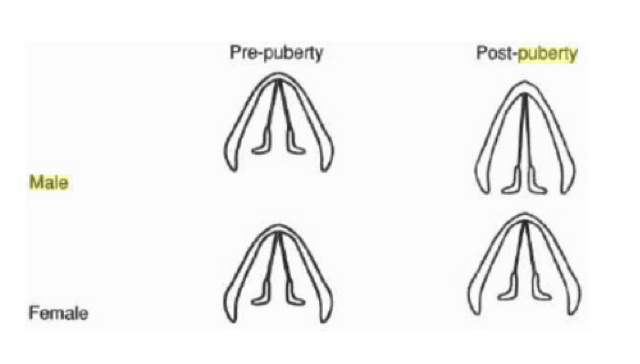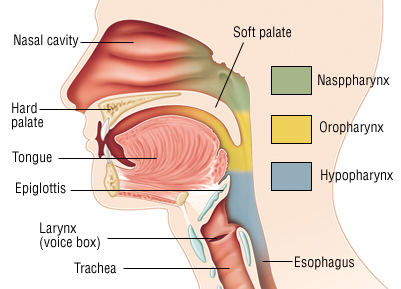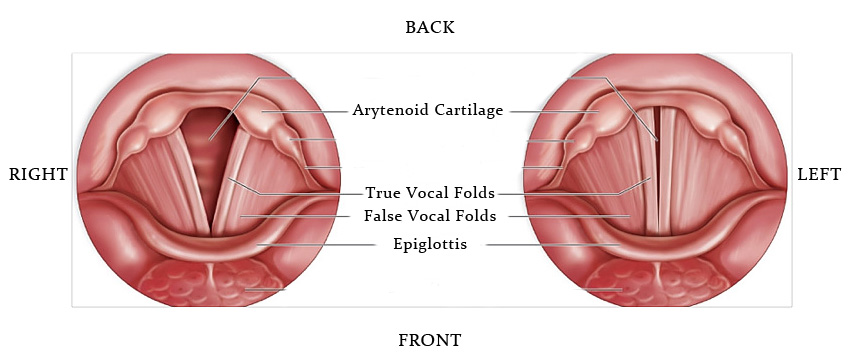Part 2 -Adolescent Voice
Part 2 - Adolescent Voice
The Adolescent Voice ~ Part 2
Frequency Change: Speaking Pitch
The voice of males at puberty often begins with a husky quality and an unsteady pitch, oscillating one or two tones. Although the pitch fluctuates day to day the trend is generally downward.
Voice change is one of the signs of female puberty. Voice change appears to begin before menarcheal onset and to continue through it. There is increased breathiness in the voice quality compared to the relative clarity of prepubertal voice quality. The breathiness is due in part to incomplete vocal fold adduction. (the vocal folds coming together)
During voicing, the membranous portion of the vocal folds adduct, but the cartilaginous portion does not achieve complete closure, forming a posterior glottal opening that is called mutational or glottal chink. Mutational chick is thought to result from insufficient contraction of the interarytenoid muscles. Poor speaking or singing habits may also influence the speaking pitch.
Frequency/pitch distinction between male and female begins during puberty and continues throughout adolescence. The voice changes are a result of growth of the phonatory, resonatory, and respiratory anatomy; roughly parallel the appearance and development of the secondary sex characteristics.
The pitch and quality changes that occur at puberty are more apparent in males then females due to the greater magnitude of the pitch change, which is approximately one octave in males.
The female voice change can be characterised by:
1. Lowering of mean speaking fundamental frequency by about three to four semitones.
2. Increased breathiness, huskiness, and hoarseness.
3. Voice cracking during speech.
4. Noticeable registers “breaks” during singing.
5. Decreased and inconsistent pitch range capabilities.
6. Singing that requires more effort and delay in phonation onset.
7. Breathy, “heavier,” “rougher” voice qualities.
The male adolescent voice change can be characterised by:
1. Sudden voice breaks
2. Huskiness or hoarseness to the voice quality and increased perturbations.
3. Uneven voice changes.
4. Timbral effects of the changing voice as it descends in pitch causes males in sing in new vocal registers.
5. Conversion aphonia and persistent falsetto (puberphonia) due to lack of vocal fold adduction and a reaction to psychologically events such as emotional stress.
6. Tessitura and register development occurs, speaking voice lowers and becomes stable in lower register.
7. The voice change occurs concurrently with other pubertal developments.
8. Different voices mature at different rates
The Adolescent Voice
The Adolescent
There are physiological and structural differences that occur in the voice during prepubescent and puberty. Understanding how and why these changes happen are useful in understanding the difficulties encountered by the young male and female vocalists.
The Adolescent ~PART 1
There are physiological and structural differences that occur in the voice during prepubescent and puberty. Understanding how and why these changes happen are useful in understanding the difficulties encountered by the young male and female vocalists.
Puberty and adolescence:
Until puberty, the larynx is of equal size in both male and females. At puberty the male laryngeal growth outdistances the female in the anteroposterior dimensions.
On the on set of puberty and during the period from 10 to 14 years, there is a dramatic period of general growth associated with the increased secretion of androgens in the male and oestrogens in the female. As the hormonal changes take place, male and female secondary sexual characteristics emerge.
The dimensions of the vocal tract reflect this period of growth and differences between males and females. Laryngeal dimensions in the male are generally larger and the thyroid cartilage changes its configuration. In Prepubescent the angel of the thyroid cartilage is 120 degrees in both female and males. During pubertal change in the male, the thyroid cartilage enlarges significantly and the angel decreases to 90 degrees, giving rise to the marked thyroid prominence known as the Adam’s apple. Increase in length of the thyroid cartilage is nearly three times greater in males than in females.
The vertical descent of the larynx during life. The illustration demonstrates the relationship of the lower border of the cricoid cartilage to the cervical vertebrae at various stages.
At birth, the lower border of the cricoid cartilage is level between cervical vertebrae 3 and 4 (C3 and C4). By age 5, the laynx has descended almost to the level of C7. Between ages 15 to 20, it remains at C7.
Vocal Folds
Before puberty, the vocal folds of boys and girls are the same size. While male’s vocal cords grow dramatically, female’s vocal cords only increase slightly.
The increased size of the laryngeal skeleton is reflected in the length of the vocal folds. In girls, the mean length of the vocal folds is 15 mm before puberty and this may increase to 17 mm in a contralto.
During the mutation period, a boys vocal folds double in length and may increase to a maximum of 23 mm in the bass voice. The minimum vocal fold length for the male is 17 mm, it can be seen that a tenor and a contralto may have much the same pitch range, but it is the larger resonators of the larynx, pharynx and the chest that distinguish the male from the female voice.
Hormones have been linked to voice changes in adolescents and adults. In puberphonia, the male adolenscent voice has a higher pitch than is typical of other males of the same age. This voice disorder is related to emotional stress, which results from psychosocial changes that occur during puberty. Conversion aphonia and persistent falsetto (puberphonia) are two functional voice disorders. In conversion or functional aphonia, there may be lack of vocal fold adduction during attempted phonation.
Above are the laryngeal changes at puberty and the transverse section of the larynx.
Dimensions of the larynx
The membranes and the cartilagionous portions of the vocal folds are equal in length in infancy creating a proportionately larger glottis. By adulthood the membranes portion with greater pliability has elongated to approximately two thirds of the total glottal length. Glottal width and infraglottal dimensions increase with age.
Ingo Titze, points out that examination of laryngeal differences;
With regard to gender reveals; the vocal fold length is significantly greater in the pubertal male then in the pubertal female. The vocal folds of the adult male are approximately thirty percent lager then those of the adult female."
The Human Voice
The human voice
The human voice is one of the most flexible and smallest instruments in the world.
In the human body, structure determines function. That is the shape and form of a structure determine the manner in which the structure will operate. Thus it is important to understand the anatomy of a structure to understand how it works.
The human voice is one of the most flexible and smallest instruments in the world.
In the human body, structure determines function. That is the shape and form of a structure determine the manner in which the structure will operate. Thus it is important to understand the anatomy of a structure to understand how it works.
The larynx has several important functions. Primarily, it is a respiratory organ controlling the flow of air into and out of the lower respiratory tract. The larynx protects the lower airway from access by anything but air and also has a role in deglutition. The role of the larynx is the primary sound generator.
Unlike songbirds, humans do not possess an organ such as a syrinx, and it is the lack of this special organ that makes technical training in singing a necessity.
The cartilages of the larynx
The arytenoid's find their points of attachment to the cartilages. Since they are located within the interior of the larynx, they are therefore intrinsic. The cricothyroid are attached the outer surface of the thyroid cartilage and they are therefore extrinsic. The intrinsic muscles of the larynx are associated with the respiration; the extrinsic muscles are connected, both neurologically and muscularly, to the process of swallowing. In phonation the two systems must reverse their natural roles and function in a coordinate relationship.
The human vocal mechanism freely functions when there is a great foundation of vocal technique.
Good singing starts from the way in which the instrument is positioned. Whether the singer is tall or short, thin or thick, male or female, structural alignment must pertain. The external frame function of the musculature of head and neck, the position of the rib cage, the relationship of the muscles of the torso to the rib cage and the sternum, and the balance of body dynamic muscle equilibrium are some principles that pertain for all singers.
Similar to the trumpet, which needs the buzzing lips to serve as the oscillator for sound production, the human voice has vocal folds to serve this function.
The larynx, which is commonly, called the voice box, houses the vocal folds and is the primary organ involved in the voice production. It is encased by the ‘Adams apple’ (also called the thyroid cartilage) and sits above the trachea (the windpipe) and in front of the oesophagus in the neck.









